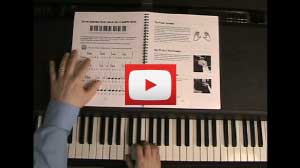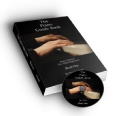Be Bop Pianists:
Thelonious Monk, Bud Powell, Hank Jones
Be Bop pianists changed jazz piano forever. Something happened at the late night jams at Minton's night club in New York City. The musicians were'nt playing for the dancers, but for their own expression. Swing cliches were forbidden, and the rules were being re-written.
Be bop was about defying the swing era norms, and finding new approaches to melody and harmony. Melodies became more angular, not as "singable," and used notes from "outside" of the scale. Be bop pianists played chords with more "tension" in the harmony, and "stabbed" at the chords off of the beat; leaving the steady left-hand patterns of swing and stride forever behind.
Thelonious Monk, 1917-1982
Thelonious Sphere Monk moved to New York with his family at the age of 4. By age 9 he was teaching himself piano, learning from piano rolls. By his late teens he was working as a jazz pianist around New York. Originally, Monk was playing a stride style, but developed his own be bop piano sound by the early 40's.
In the early 40's Monk got a gig at Minton's, where musicians would gather to jam. From theses jams emerged the new music, "be bop." Some of the other creators of bop at Minton's included Charlie Parker, Dizzy Gillespie, Miles Davis and Charlie Christian. Monk's piano style evolved into a very unorthodox approach to the keys. His playing became very percussive, with an emphasis on seconds in the right hand improvisations. His wife Nellie called his style "melodious thunk."
His first major recording was in 1944 with Coleman Hawkins, and he made his first record with Blue Note in 1947.
In 1951, while with his friend Bud Powell. the New York police searched his car and found drugs. Monk refused to testify against Powell, and subsequently lost his cabaret card, preventing him from playing NYC clubs for six years. This began the first period of seclusion for Monk.
During the 50's Monk was signed to Prestige Records, and recorded with Sonny Rollins and Art Blakey, among others. He later signed with Riverside and had a quartet with John Coltrane. By 1962, Monk's star had risen enough to be signed to Columbia Records, the largest U.S. record company, and produced a string of his best-selling records.
By the 70's, Monk was playing occasional concerts and living in seclusion again at the home of his friend and benefactor Baroness Pannonica Koenigswarter, where he later died.
Thelonious Monk will be remembered as a be bop pianist with a unique style and vast influence on jazz. Many of his songs have become part of the standard jazz repertoire, including "Blue Monk," "Well You Needn't," "Round Midnight" and "Straight, No Chaser."
Bud Powell, 1924-1966

Bud Powell was born and raised in New York. Both of his parents were musicians, and his father was a professional stride pianist. Bud started piano lessons at age 6, studying the classics. He especially enjoyed playing Mozart.
By 1940, Bud's own jazz style was starting to emerge. He became a regular at Minton's, and Thelonious Monk took the younger Bud Powell "under his wing," and they soon became great friends. Sometime later, Powell was assaulted in a racial incident, resulting in a head injury. This led to serious mental problems that would put him in and out of sanitoriums for the rest of his life.
Powell rarely appeared in clubs with his trio, or performed with others. He moved to Paris in 1959 and was treated as a celebrity. He later performed a homecoming concert at Carnegie Hall in 1964, but it resulted in disaster, because he wasn't up to the task mentally.
Of the be bop pianists, Bud Powell is the most influential. His innovations would transform jazz piano. His quick right hand lines were supported by sparse left hand chords, sometimes using as few as two of three notes. His right hand played melodies like a horn player, but with free melodic invention; both fast and very creative. Though influenced by Monk, he had technique that rivaled Art Tatum's. His style, and especially the use of only seconds and sevenths in the left hand became the standard way to play jazz piano, influencing almost every player to come after him.
Hank Jones, 1918-2010
Hank Jones grew up in Pontiac, Michigan in a musical family of eight children. His siblings include both Elvin and Thad Jones, both jazz greats in their own right. Hank was trained with the classics, but really enjoyed playing Fats Waller stride pieces. Hank worked around Detroit, then made it to New York with his brothers.
His first gig in New York was with Hot Lips Page on 52nd St. He soon got into the be bop breweing all around him, but he always kept one foot in the swing world. Hank was as comfotable playing with Benny Goodman as with Charlie Parker. He had as much repect for the old as for the new bop.
He first recorded in 1944, and soon became one of the most sought-after accompanists in jazz. Hank's reputation for always supporting the leader, playing thoughtful musical lines and playing with a sense of dignity led to his playing on over 1,000 sessions throughout his career. A short list includes Lester Young, Dizzy Gillespie, Ben Webster, Artie Shaw and Coleman Hawkins.
Hank Jones was a staff musician at CBS from 1958-73, including working on the Ed Sullivan Show. He later spent five years as Ella Fitzgerald's pianist, and then as the pianist in the Broadway show Ain't Misbehavin'.
Of the be bop pianists, Hank Jones is known for playing bop that was musical, developing melodic motifs, and having a style that was supportive of the other musicians in the group.
Start Playing Piano Today with the Piano Guide Quick Start Course!
Easy to follow step-by-step lessons designed for adult beginners. The next best thing to private lessons!
What You'll Learn:
- Notes on the piano/keyboard
- Proper fingering
- C major scale
- Chords
- How to read music
- And much more!

Video lessons - watch as I play everything for you.

